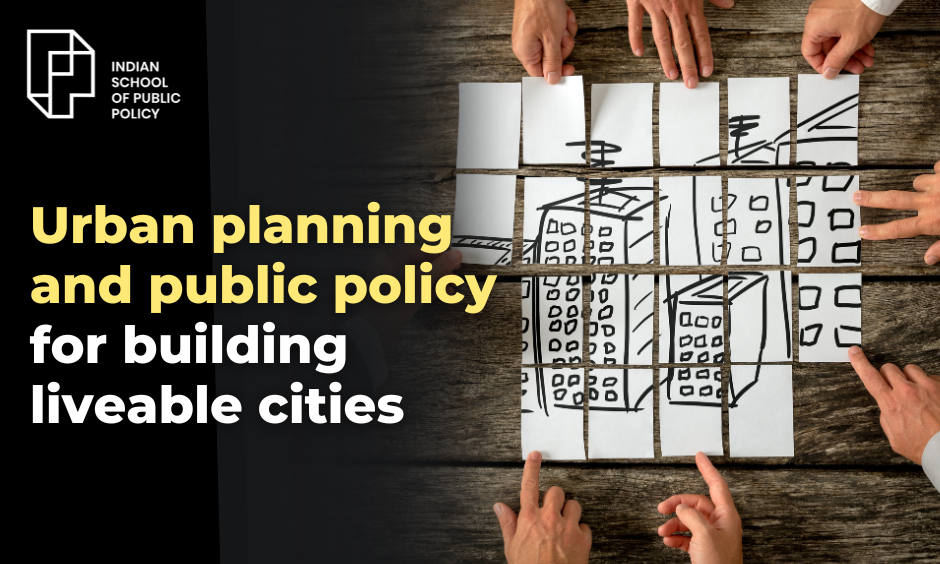
Urban planning and public policy for building liveable cities

Urban areas worldwide
Urban areas worldwide are increasingly grappling with traffic congestion. Projections indicate that this issue will only escalate in the future, leading to heightened congestion, reduced space availability, and hindered mobility for both goods and people. To address these challenges effectively and to foster sustainable, livable cities, there must be a cohesive alignment among political visions, comprehensive plans, and thorough evaluations.
Types of urban planning
Urban planning encompasses a wide range of elements and endeavours, including the organisation of buildings, utilisation of open spaces, transportation systems, and socio-economic functions within urban areas.
Here, we explore seven essential types of urban planning:
Strategic urban planning defines overarching goals and identifies the best areas for urban or metropolitan growth. This phase typically involves the creation of a strategic plan, often referred to as the core strategy or development plan.
Objectives within a strategic plan may include –
- Elevating the quality of life for urban residents
- Attracting new residents or visitors
- Creating additional public spaces for recreation and socialising
- Improving the city’s transportation options.
Land-use planning entails the creation of regulations and policies that govern how land parcels are utilised. These regulations influence the land’s intended purposes and during this phase, governmental rules, zoning laws, and legislation are established to dictate land usage. These planning tools also determine the quantity, type, and location of land required for various municipal services. Land can be designated or zoned for residential, commercial, municipal, or industrial purposes, encompassing a range of building types and facilities such as single-family residences, office buildings, government structures, and industrial facilities.
Infrastructure planning involves the strategic development of essential structures and systems to meet the needs of a city and its residents. It aims to align these facilities with the goals outlined in the strategic plan. This type of planning encompasses various aspects, including:
- Transportation and safety measures such as roads, police stations, and fire stations.
- Community infrastructure like parks, hospitals, and schools
- Public works infrastructure such as telecommunications, water supply, energy, and sewage systems.
Effective infrastructure planning is expected to enhance the quality of life for residents by providing improved access to essential services and amenities.
Urban revitalisation, a lesser-known aspect of city planning, focuses on rejuvenating urban areas that are perceived to be in decline. Various factors, such as local business closures or stagnation in population growth, can contribute to the decline of businesses and communities within a city. However, without revitalisation efforts, these deteriorating areas may lose their appeal to potential investors and residents.
Urban regeneration strategies vary depending on the underlying causes of decline, but common revitalisation techniques include:
- Reducing pollution levels
- Enhancing parks and recreational areas
- Repairing heavily used roads
- Constructing new infrastructure to spur economic growth and improve overall livability.
Master planning, a fundamental aspect of urban planning, primarily involves the development of undeveloped land and is often more complex and time-intensive than other planning methods. It aims to shape future land use and infrastructure comprehensively. Urban planners must carefully consider zoning regulations, infrastructure needs, and the inclusion of amenities like parks and schools. Collaboration with government bodies and local stakeholders is essential throughout the master planning process to ensure its success.
Economic development is crucial in urban planning as it identifies potential areas for urban expansion, fostering financial success and attracting businesses. For instance, Amazon’s search for its second headquarters highlighted the economic benefits such developments bring, including job opportunities and growth. Urban planners work alongside other planning strategies to ensure seamless implementation of development projects.
Environmental planning, part of sustainable development plays a pivotal role, requiring urban planners to address various ecological factors. These include shoreline erosion, floodplain vulnerability, noise pollution, threatened animal habitats, and wetlands. Environmental planning is integral to infrastructure, master, and revitalisation plans.
The role of public policy in urban planning and building liveable cities
Public policy is a structured approach, typically implemented through programs, which consists of laws, rules, guidelines, and actions designed to tackle real-world issues. It encompasses all government actions, both direct and indirect. Policy planning is aimed at shaping both national and local policies that affect urban services and expansion. This involves the processes of policy-making, organisation, and evaluation.
So, how can we use policy-making to build sustainable and livable cities?
We start by:
Setting ambitious and long-term goals
Establishing ambitious, long-term objectives is crucial for the policy-making related to sustainable mobility, addressing both current and future traffic issues. In Denmark, transport planning is conducted at national, regional, and local levels, each with their own ambitious objectives. For example, Copenhagen aims to enhance livability and achieve carbon neutrality by 2025, which drives the creation of dedicated, long-term plans aligned with these visions.
Integrated solutions to planning
Creating more livable cities requires a comprehensive and intelligent approach to sustainable mobility. This involves collaboration across different sectors, policy domains, and levels of government, as well as engaging citizens and stakeholders in ongoing dialogue. Experience has demonstrated that continuous dialogue among politicians, administrators, and private stakeholders fosters dynamic progress toward achieving vision goals. Unlike traditional transport planning, urban mobility planners now emphasize coordinating policies across multiple sectors, such as land use, environment, social policy, and transport. The integrated solutions resulting from sustainable mobility planning can harness synergies between these sectors for the betterment of urban areas.
Assessing the progress
To ensure we are making progress toward our goals, it is crucial to determine when to allocate more resources, extend timelines, or adjust goals as necessary. For instance, the city of Copenhagen uses green accounts to track its progress. These tools facilitate constructive dialogue and provide valuable insights for making informed decisions. They offer an overview of the overall vision and help to understand the connections between different goals. Creating livable cities with sustainable urban mobility relies on maintaining long-term visions, employing integrated planning strategies, and conducting ongoing assessments of progress. This emphasises the importance of collaboration across stakeholders, sectors, and levels of government.
Complex yet intriguing, right?
Well, policy-making is an art! If you aspire to be an artist in this field, you must acquire the necessary knowledge and skills to make a significant impact. There are two educational pathways you can consider:
A Master’s in Public Policy VS a Post Graduate Programme in Public Policy (PGP)
Master’s in Public Policy (MPP) programme focuses on government policies and their societal impacts. It aims to provide a strong foundation for policy analysis, implementation, and evaluation. Graduates pursue careers in government, nonprofits, and international organisations.
Meanwhile, a Post Graduate Programme in Public Policy (PGP) in India equips students with policy-making and implementation skills. It’s designed for those aspiring to work in various sectors engaging with public policy. The curriculum covers economics, political science, law, and more, emphasising analytical skills and research methodology. Graduates are prepared to evaluate policy issues and design evidence-based solutions. When choosing a programme, consider factors like admission requirements and career prospects.
Since the Post Graduate Programme in Public Policy in India seems to be a holistic programme, let’s understand
The Post Graduate Programme in Public Policy (PGP) By ISPP
The Post Graduate Programme in Public Policy offered by the Indian School of Public Policy (ISPP) stands as a prestigious and thorough initiative, meticulously crafted to prepare students for impactful careers in public policy. The programme ensures that students acquire vital knowledge, skills, and values essential for success as policy professionals in government, civil society, or the private sector.
Register your Interest to Study at ISPP
World-class Faculty
As the top public policy school in the nation, ISPP boasts a faculty comprising esteemed academics, researchers, and practitioners from various fields. Our faculty members bring a wealth of knowledge, specialized expertise, and extensive experience to the institution, enriching the learning experience for our students.

Placements
Students at ISPP explore potential career opportunities in various sectors, including government, NGOs, think tanks, academia, and public and industry bodies. Additionally, they receive support for off-campus job opportunities and interviews.

Infographics:

FAQS
What are the key challenges urban areas face in terms of traffic and mobility?
Urban areas worldwide experience increasing traffic congestion, leading to reduced space availability and hindered mobility for both goods and people.
What are the essential types of urban planning?
Urban planning encompasses seven fundamental types: strategic urban planning, land-use planning, infrastructure planning, urban revitalisation, master planning, economic development planning, and environmental planning.
How does environmental planning contribute to urban development?
Environmental planning addresses ecological factors such as shoreline erosion, floodplain vulnerability, noise pollution, threatened habitats, and wetlands. It is integrated into infrastructure, master planning, and revitalisation efforts to ensure sustainable urban development.
What role does public policy play in building sustainable cities?
Public policy serves as a structured approach, consisting of laws, rules, guidelines, and actions aimed at addressing real-world issues. It shapes national and local policies affecting urban services and expansion, involving policy-making, organisation, and evaluation.
What are the differences between a Master’s in Public Policy (MPP) and a Post Graduate Programme in Public Policy (PGP)?
While an MPP focuses on understanding government policies and their societal impacts, a PGP in Public Policy in India emphasises policy-making and implementation skills across various sectors. Graduates of MPP programmes typically find employment in government, nonprofits, and international organisations, while PGP graduates are prepared for roles involving public policy across different sectors.


